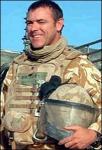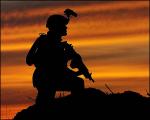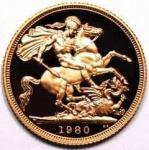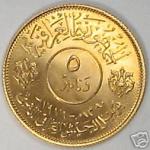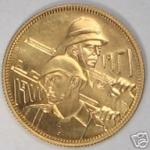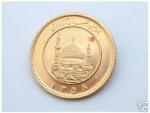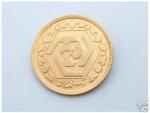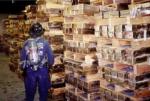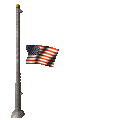-
Posts
3,575 -
Joined
-
Last visited
-
Days Won
27
Content Type
Profiles
Forums
Blogs
Gallery
Events
Store
Everything posted by bigjarofwasps
-

Op Telic Casualties & Fatalities
bigjarofwasps replied to bigjarofwasps's topic in Modern Campaigns and Conflicts
Lance Corporal Dennis Brady was hit in an "indirect fire attack" at the Shatt Al-Arab Hotel after mortars landed inside the UK base in Basra, southern Iraq, on 1 October. The 37-year-old, from Cumbria, was a regular reservist from the Royal Army Medical Corps, attached to the 1st Battalion of the Light Infantry. L/Cpl Brady grew up in Barrow-in-Furness, Cumbria, where he lived with his wife, Zoe. He left the regular Army in 2004 and worked as a firefighter before volunteering to return to the military as a reservist. His commanding officer, Lt Col Johnny Bowron, said: "His loss will be keenly felt, and the battalion has lost a trusted member and a real friend." SOLDIER Dennis Brady’s mum received birthday flowers from her son in Iraq the day before learning of his death. And the Lance Corporal was just two weeks from coming home to Barrow when he was killed in a mortar attack. LANCE Corporal Den Brady’s wife is today mourning a man she says “died a hero.” Zoe Brady, 30, of Barrow, has been married to the 37-year-old Army medic for six years but they have been separated for some time. They have no children. Speaking exclusively to the Evening Mail, she said: “Den lived life to the full. He put 100 per cent into everything he did. “His death will leave huge voids with every body who loved him. “Words cannot express how much he will be missed. “He died a hero.” British soldier killed in Basra A British soldier has been killed and another injured during an attack at a UK base in Basra, southern Iraq, the Ministry of Defence has said. The two soldiers were said to have been hit in an "indirect fire attack" at the Shatt Al-Arab Hotel after mortars landed inside the base perimeter. The dead soldier was from the Royal Army Medical Corps. The soldiers' names have not yet been released by the MoD. The death on Sunday brings the British death toll in Iraq to 119. A British military spokesman in Basra about 15 mortars were fired at the base, with three or four landing inside the perimeter. The soldiers were taken to hospital, where one later died. The other suffered a broken arm, the spokesman said. http://www.mod.uk/DefenceInternet/DefenceN...illedInIraq.htm -

Roll of Honour Afganistan
bigjarofwasps replied to bigjarofwasps's topic in Modern Campaigns and Conflicts
-
There was no change in the trading pattern on the bullion market today as gold notched up further ground on sustained buying and silver moved up on the local support. Marketmen said the gold prices continued to gain in day-to-day buying by retail customers and stockists influenced by a firm trend in the overseas markets. The yellow metal in other Asian markets hovered around $ 321 an ounce from previous level of $ 318. They said worries over the potential repeat of any terrorist attack together with continued attempts by the USA to draw up support for attacking Iraq lent gold a good bullish tone. Standard gold and ornaments gained further by Rs.20 each at Rs 5,300 and Rs 5,150 per 10 gram. Sovereign also jumped up by Rs 75 at Rs 4,150 per piece of eight gram. While silver ready rose by Rs 45 at Rs 7,770 per kilo and weekly-based delivery by Rs 40 at Rs 7,780 per kilo, silver coins gathered fresh support from the local parties and registered a gain of Rs 100 at Rs 11,600/11,700 per 100 pieces. The following were today’s quotations: Silver ready 7,770 and delivery 7,780. Standard gold 5.300, ornaments 5,150 and sovereign 4,150.
-
Oil and gold prices jumped on Monday and stock prices fell as the standoff between the United States and Iraq and the impending anniversary of the September 11 attacks spooked investors. The dollar pushed higher against the euro and yen, extending gains made after Friday’s upbeat U.S. jobs data, but worries over possible U.S. action against Iraq kept the market nervous. Interest rate futures slid after European Central Bank President Wim Duisenberg said at the weekend that euro zone monetary policy was appropriate for the foreseeable future. Gold, viewed as a safe haven in times of geopolitical turmoil, topped the $320 an ounce mark for the first time since July with investors anxiously awaiting the anniversary of the attacks on New York and Washington. “The current environment remains clearly supportive to gold... The potential for major terrorist attacks remains extremely high,” said Kamal Naqvi, metals analyst at the Macquarie Research. The oil prices rose in Asia for the fourth consecutive session on fears that any escalation in the West Asia violence could disrupt supplies from the region, which accounts for two-thirds of the world crude reserves. Brent crude futures for October delivery were 13 cents higher at $28.42 a barrel. Nervousness over a possible U.S. attack on Iraq also helped push European stocks lower, though dealers also blamed profit-taking after sharp price rises on Friday. “The move on Friday was very strong, largely due to short-covering, and we are seeing some profit-taking today, though the main worry of the market remains Iraq,” said Thierry Lacraz, a European strategist at Geneva-based bank Pictet & Cie.
-
Gold price sparks a new rush Gold is coming back into fashion, not as jewellery but as bars and sovereigns. More and more people, wearied by plunging share prices, poor returns on savings and a possible crash in the housing market, are looking at gold as an alternative investment. Fears about war with Iraq have helped push up the price to about $360 an ounce and bounced the precious metal back into the headlines. And that has woken up ordinary investors in the UK who had forgotten about gold. Selling krugerrands "Nobody ever hears about the gold market out on the street until war breaks out," says Jeremy Kyd, trading manager at the bullion merchants Baird & Co. "It's supposed to be a shiny thing, it's supposed to have this flight to quality, people see it as a safe haven, it used to back currencies; and gold is still there." Mr Kyd says that since the beginning of this year the company has seen a 20% increase in general enquiries about buying the precious metal. The high price has also encouraged selling: "We have seen quite a few people coming out of the woodwork selling the krugerrands they got in the sixties." Piling in Baird's customers are generally companies investing large amounts of money in gold bars. But individuals can buy gold coins ranging in price from ?24 to several hundred pounds. Anyone wanting to buy gold bars has to be an account holder with a minimum of $5,000 to invest. "A lot of people are piling their money into gold at the moment," says Justin Modray, investment manager at the independent financial advisers RJ Temple. For the first time that he can remember, clients have been coming for financial advice and mentioning gold as a possible investment. "It tends to be a relatively good bet at the moment because gold is a good hedge against stock markets, and cash is paying not particularly good returns at the moment." He says that gold sovereigns are the main way of investing. Jewellery is not such a good option because you pay a premium for the workmanship. Gold bars are the next step up, but an investor will also have to pay ?100 or more a year to keep them in storage. Beating the stock market There is another way to invest in gold without buying the precious metal itself - through a unit trust. The Merrill Lynch Gold and General Trust rose 53% last year while world stock markets were falling. The fund invests in gold mining company shares and has a small holding in platinum and silver equities. Richard Davis, who manages the fund, says interest from investors has increased over the last year and more particularly in the last few weeks. The fund invests in gold shares rather than the metal itself because the potential gains are greater. "When the gold price goes up the shares go up. If the gold price rises by 10%, gold shares rise by 30% to 50%," says Mr Davis. "But it's the same on the downside. If the gold price falls 10%, the shares will fall by 30% to 50%." Selling off gold reserves It is not just the fear of war with Iraq that has pushed gold higher. The price peaked at $850 an ounce in January 1980 when the oil price was very strong and Middle East producers invested in gold. But the price fell back and was further hit in the 1990s when many of the world's central banks were selling off their gold reserves. An agreement in 1999 to limit the amount of gold they sold onto the markets helped the metal to regain its lustre. But until now there has not been any demand from individual investors. Getting caught out "There's a whole lot of people paying interest to gold: it's like a market waiting to be tapped by somebody. "What it really needs is for one of the major High Street banks to re-adopt sales of gold over the counter," says Kevin Crisp, precious metal strategist at Dresdner Kleinwort Wasserstein. In Germany it is possible to buy small gold bars and coins and open gold accounts in bank branches. But anyone thinking of moving their money into the precious metal should beware. "Gold is not a panacea. However, as part of a portfolio it can play a role," says Mr Crisp. And Mr Modray warns that, all too often, investors can get caught out by the markets. "The majority of people tend to chase performance when it comes to investment."
-
The way thing seem to be going in that part of the world, I think we may find out soon than we`d planned!!!!
-
Here`s another, sorry but I`ll never grow tired of this thread!!!!!!!!!! Another HOT Iranian chick!!!!!!!!
-
Tuesday, 5th September 2006 10:58 Persian Gold says drilling programme started at Iranian gold prospect LONDON (AFX) - Persian Gold PLC said a 10 hole drilling programme has started at the Chah-e-Zard gold prospect near Yazd in Iran. The drilling is expected to take up to three months to complete and will test the continuity at depth of the strong surface gold values previously reported. A trenching programme to test the lateral extensions of gold mineralization at the surface is nearing completion. Persian Gold holds an option to buy 70 pct of the Chah-e-Zard project with the remainder held by a local Iranian company.
-
Persian Gold plc Persian Gold plc is an Irish based AIM quoted company established to discover and develop gold deposits in Iran. This country hosts an extensive belt of volcanic rocks that has been the source of significant metal deposits throughout the history of the region. The development of new geologic exploration models for gold in volcanics, applied primarily in South America in the last 10 years, is now being used with positive results by Persian Gold in this region. Persian Gold plc operates two intriguing gold projects. Chah-e-Zard, located in central Iran, is an advanced stage project with very strong surface gold values over a one square kilometre area of strongly altered volcanic rocks. The Takestan project, located northwest of Tehran, is an earlier stage gold project where extensive silica-alunite alteration of volcanics has returned widespread indications of low grade gold mineralization. The Company’s strategy is to discover significant volcanic hosted gold deposits similar to those discovered in South America in the past 10 years which have developed into some of the largest and most profitable gold mines in the world.
-
Iranian Gold Rush Highlights Escalating Tensions Thursday, April 20, 2006 With the war of words over Iran’s nuclear programme escalating and the domestic economy stalling, Iranians are scrambling to buy gold coins, sending their value soaring by 32 per cent in the past two months. “It’s unbelievable,” blazed a front page story in Etemad-e Meli, a reformist newspaper, earlier this week. “It seems no investment field is as safe.” “Gold coins are Iranians’ political hedge fund,” says Heydar Pourian, editor of Iqtisad Iran (Iran Economics), a monthly magazine. “We keep them at home and they make us feel secure.” Commodity prices have risen worldwide over recent years partly in response to Middle East tensions centred on Iraq, but Iranians are now starting to feel they may be at the centre of a growing storm. Hence the appeal of gold coins given as presents for weddings and new year; gold coins are a liquid and proven investment. And at 460,000 rials (about $41.50) a quarter, gold coin is within reach for all but the poorest Iranian. By contrast, Iran’s largely state-owned banking sector offers limited services, while investors face inflation put officially at 14 per cent. While deposits in state banks lost 1 per cent in real terms in the year to February 2006, gold coins gained 21 per cent. “Buying gold coins reflects a lack of alternatives,” says Mr Pourian. “Big investors may pull out of real estate and move their capital to Dubai. Smaller investors have fewer opportunities.” Businessmen say the rush to gold reflects both growing tension over Iran’s atomic activities and the destabilising economic policies of fundamentalist president Mahmoud Ahmadi-Nejad, whose government took office last August. “The direction reverses the years of [president Mohammad] Khatami and increases the role of the state, especially in allocating resources,” says one. “It’s more like communism than Islam, and makes you think some of them want a siege economy ready for war.” READ MORE The government buzz-phrase is “directed lending”, through which banks shape lending policies to suit governmental priorities for regional development and agricultural self-sufficiency. State banks, already undercapitalised, face increasing demand after the president has made hundreds of loan promises, especially on high-profile provincial trips. Lending rates have been cut to 16 per cent, with subsidised exceptions including farm loans at 9 per cent. The banks, already in confusion after the new government replaced seven heads of state banks, are facing calls from ministers and fundamentalist parliamentary deputies for further reductions. Lower lending rates mean lower returns for small depositors such as pensioners who, already wary of inflation, are among those fuelling rising demand for gold coins. One of the first acts of the Islamic Republic after the 1979 revolution was to issue Bahar-e Azadi (spring of liberty) gold coins.
-
Iranian gold mine plans advance 17:11:35 GMT, 07 June, 2006 Plans for the Zarshuran Gold Mine in Iran are continuing to develop in the East Azarbaijan Province, it has been reported. The Persian service of ISNA says that new bids are still emerging, with the qualification process now likely to mean a final decision on the mine will not be taken for several months. Work is expected to begin in March 2007, with project director Mahmud Yeganli detailing the latest developments. "So far, 28 companies in eight groups have purchased the preliminary forms and seven groups are expected to qualify for the final run," he said. "They will then be invited to obtain the main documents for the final bid." The bid process is expected to last for several months, as international tender laws and bid criteria are examined. Around 300 tonnes of gold are bought and sold in Iran each year according to estimates.
-

Medals for service in Iraq
bigjarofwasps replied to mariner's topic in Modern Campaigns and Conflicts
-

Twin Towers........
bigjarofwasps replied to bigjarofwasps's topic in Coins & Commemorative Medallions
And there`s more....... http://www.sierratimes.com/archive/files/n.../arjj110101.htm http://www.8thestate.com/?page_id=11 http://www.cnsnews.com/ViewPrint.asp?Page=...S20010912b.html -
Missing Gold A King's Ransom in Precious Metals Seems to Have Disappeared The basement of 4 World Trade Center housed vaults used to store gold and silver bullion. Published articles about precious metals recovered from the World Trade Center ruins in the aftermath of the attack mention less than $300 million worth of gold. All such reports appear to refer to a removal operation conducted in late October of 2001. On Nov. 1, Mayor Rudolph Giuliani announced that "more than $230 million" worth of gold and silver bars that had been stored in a bomb-proof vault had been recovered. A New York Times article contained: Two Brinks trucks were at ground zero on Wednesday to start hauling away the $200 million in gold and silver that the Bank of Nova Scotia had stored in a vault under the trade center ... A team of 30 firefighters and police officers are helping to move the metals, a task that can be measured practically down to the flake but that has been rounded off at 379,036 ounces of gold and 29,942,619 ounces of silver .. 1 ? Reports describing the contents of the vaults before the attack suggest that nearly $1 billion in precious metals was stored in the vaults. A figure of $650 million in a National Real Estate Investor article published after the attack is apparently based on pre-attack reports. Unknown to most people at the time, $650 million in gold and silver was being kept in a special vault four floors beneath Four World Trade Center. 2 ? An article in the TimesOnline gives the following rundown of precious metals that were being stored in the WTC vault belonging to Comex. 3 ? Comex metals trading - 3,800 gold bars weighing 12 tonnes and worth more than $100 million Comex clients - 800,000 ounces of gold with a value of about $220 million Comex clients - 102 million ounces of silver, worth $430 million Bank of Nova Scotia - $200 million of gold The TimesOnline article is not clear as to whether the $200 million in gold reported by the Bank of Nova Scotia was part of the $220 million in gold held by Comex for clients. If so, the total is $750 million; otherwise $950 million. There appear to be no reports of precious metals discovered between November of 2001 and the completion of excavation several months later. Assuming that the above reports described the value of precious metals in the vaulst before the attack, and that the $230 million mentioned by Giuliani represented the approxmiate value of metals recovered, it would seem that at least the better part of a billion dollars worth of precious metals went missing. (It is not plausible, of course, that whatever destroyed the towers vaporized gold and silver, which are dense, inert metals that are extremely unlikely to participate in chemical reactions with other materials.) An article in The Sierra Times suggests that gold was recovered from two trucks in a tunnel under 5 World Trade Center, giving rise to suspicions that the trucks were being used to remove the gold from the vaults before the South Tower fell. 4 ? However, this report may have been based on an erroneous reading of other reports that describe the removal of crushed vehicles from a tunnel under 5 WTC in order to gain access to the vaults under 4 WTC to remove their contents. 5 ? Why is there this huge discrepancy between the value of gold and silver reported recovered, and the value reported to have been stored in the vaults? There are a number of possible explanations, from outright theft using the attack as cover, to insurance fraud. Until there is a genuine investigation that probes all the relevant facts and circumstances surrounding the attack, we can only speculate.
-
Teacher, coach, husband, son, soldier, hero laid to rest Hometown honors young soldier who touched their lives Andrew P. Wallace was many things to many people. To his students, he was Mr. Wallace. To his soldiers, he was Sgt. Wallace. To his wrestlers, he was Coach Wallace. To his wife and family, he was Andy. To the citizens of Ripon who turned out Thursday to honor his memory, he was a hero. Before Wallace, 25, was killed in Iraq Sept. 26, he was a student, a teacher, a wrestling coach, a soldier, a son, a husband. Last week, after news of Wallace's death spread through the Oshkosh school district, where he was a physical education teacher, his pupils at Emmeline Cook Elementary School were encouraged to write poems about him, and his colleagues got together to laugh and cry while recounting their memories, said school Principal Phil Marshal. "I realized that in two short years this young man had touched every person's heart in some way," Marshal told an overflow crowd of several hundred mourners at Grace Evangelical Lutheran Church in Ripon. In addition to teaching physical education at Emmeline, Wallace also taught special needs students and was an assistant wrestling coach at Oshkosh North High School. After graduating from Ripon High School, Wallace earned a degree from the University of Wisconsin-Oshkosh and applied to teach in Oshkosh two years ago. School officials learned late in the summer about an opening at Emmeline and pulled out Wallace's r?sum? from a stack of applicants. Wallace made a good impression during his interview, but when offered a position, he told officials he already had a job offer in another school district, said Marshal. Despite that offer, Wallace ultimately decided to stay in Oshkosh. "Having the chance to work close to home to be close to his family was very important to him," said Marshal. Wallace was known for his energy and his love of teaching; he wasn't content to let his students go through agility and strength drills on their own - he would usually join them. The principal noted that Wallace coordinated a jump rope event to raise money for the American Heart Association, and students were proud to raise more than $6,000, and "it was Mr. Wallace who sparked their interest." Next to a portrait of Wallace and his flag-draped casket in the church was a fallen soldier monument of tan combat boots, upturned rifle and desert camouflage helmet with goggles. Military officials presented several commendations, including a Bronze Star and Purple Heart, to Wallace's wife, Angie. The couple celebrated their first anniversary in July. Wallace and Spc. Michael Wendling, 20, of Mayville were killed when their Humvee was hit by a roadside bomb while traveling in Shaibah, near Basra in southern Iraq. Injured in the blast was Spc. Jeremy Roskopf of Brownsville, Wendling's Mayville High School classmate, who suffered shrapnel wounds to his legs. Roskopf attended Wallace's funeral Thursday. They were members of Fond du Lac-based Charlie Company of the Wisconsin Army National Guard 2nd Battalion, 127th Infantry Regiment. The unit, which arrived overseas in August, is based in Kuwait and provides security for convoys traveling on the main supply route in Iraq. Tim Wallace told mourners how much he misses his brother and said that if he could have three seconds with him, he would spend the time saying how much he loved his brother. "I never thought I'd go through life without Andrew. I never thought when I said goodbye to Andrew at Volk Field it would be the last time I would see him," said Tim Wallace. "My brother was a hero. Always keep him in your hearts and in your minds." Wallace was buried at a cemetery on the outskirts of his hometown. Traffic backed up as the long line of cars snaked through the community from the church to the burial ground. A military honor guard stood at attention at an intersection. As the black hearse carrying Wallace's casket traveled the tree-lined streets Thursday afternoon, townsfolk walked out of their homes and businesses and schools. They stood on the sidewalks and held small American flags. Some waved, some saluted, some held their hands over their hearts as they watched a soldier travel to his final resting place. Mourning, interrupted Officials hope to block protests at soldiers' funerals Not everyone who came to Sgt. Andrew P. Wallace's visitation in Ripon was welcome. Among those who stopped by were four adults and three children from the Kansas-based Westboro Baptist Church who hailed the soldier's death, saying it was God's revenge on a country that accepts homosexuality. They dragged a U.S. flag on the ground while carrying signs that said "Thank God for dead soldiers" and "Thank God for IEDs," a reference to the improvised explosive device that killed Wallace. "My son died for their right to protest, I guess," said Pete Wallace of Fox Lake. "(But) I can't emphasize enough that it's the wrong forum for them to be in." Westboro church members have protested at ceremonies for two other Wisconsin National Guard soldiers who died in Iraq, according to the group. The 75-member church, made up primarily of members of Rev. Fred Phelps' extended family, believes God is punishing America for its sinful ways. This week, the group celebrated the deaths of 12 West Virginia miners. On Thursday, the Wisconsin National Guard's top lawyer, Staff Judge Advocate Julio Barron, alerted Gov. Jim Doyle's office to the issue, saying the National Guard wanted to "maintain dignity at funerals of fallen service members." The letter notes that there is little that police, legislators and local officials can do because of free speech rights. Sen. Ron Brown (R-Eau Claire), the chairman of the Senate's veterans committee, said he planned to meet with the National Guard to discuss the matter. He said lawmakers might be able to draft a bill that would require protesters to be a set distance from funerals or find ways to otherwise protect families, but he stressed that it would be difficult. "There's a time and a place for this stuff, and a funeral is not the time or place," Brown said. "I don't want to step on anybody's constitutional rights here. . . . It would be hard to stop them." A Doyle spokesman said the governor would support legislative action. "The Legislature will have to figure out what they can do constitutionally, but anything that can ease the family's suffering and get these kooks out of the way of these intimate family moments, he's in support of," aide Dan Leistikow said. The letter to Doyle said the National Guard and Attorney General Peg Lautenschlager are monitoring the church's activities at funerals. It says other states are contemplating making disorderly conduct at soldiers' funerals a felony, but Lt. Col. Tim Donovan said the National Guard was not advocating passing such a law here. Lautenschlager sent a letter to Monroe County officials in November warning them that the church planned to protest at the funeral of Pfc. Alex Gaunky of Sparta. The group never showed up, however. Lautenschlager said in her letter that protesters could be arrested for disorderly conduct in certain situations, and she encouraged law enforcement officers to videotape any protests. Governor troubled by protests Doyle saw the protesters when he attended the Oct. 5 funeral of Spc. Michael Wendling in Theresa, near his hometown of Mayville. Doyle "finds it totally abhorrent they would try to disrupt and cause pain to these tremendous families," Leistikow said. The same day, the group protested at Wallace's visitation in Ripon. On Nov. 10, they demonstrated in Hudson at Spc. Benjamin A. Smith's funeral. Video taken by the group outside Wendling's funeral shows Dodge County Sheriff Todd Nehls telling them not to carry signs that said "Thank God for dead soldiers" and "Your pastor is a whore" and ordering them not to desecrate a flag. Church member Shirley Phelps-Roper said that Nehls hit her sister-in law, Paulette Phelps, during the altercation; what transpired is not clear from the video footage posted on the church's Web site, http://www.godhatesfags.com/. Nehls tells them on the tape they must hide two of their signs for their protection. "I think some people may read some of your signs and be so offended that they may storm from across the street and cause you harm," he says on the tape. No one is visible on the other side of the road in the video. Nehls could not be reached for comment. "He was violating the Constitution with every breath he took and every word he spoke," said Phelps-Roper. Her group will not take legal action against the county. "There's nothing we could do to Nehls that the Lord couldn't do better than us," she said. The group has protested outside about 80 funerals and visitations nationwide, said Phelps-Roper, a lawyer and daughter of Fred Phelps, who over the years has protested around the country bearing a "God hates fags" sign. Phelps-Roper said her group chose to protest at soldiers' funerals because God was sending a message to Americans by killing troops with the improvised explosive devices. "His weapon of choice is the IED, so our forum of choice must be these soldiers' funerals," she said. She said all troops were complicit in America's sinfulness because they had agreed to serve their country's government.
-
Memorial Ceremony In Honor Of SGT Andrew Wallace SPC Michael Wendling 2-127th Infantry Battalion (L) 0800 Hrs 30 September 2005 Camp Navistar, Kuwait 37th Transportation Group 2-127th Infantry Battalion In Honor Of SGT Andrew Wallace and SPC Michael Wendling C Co. 2-127th Infantry IN MEMORIUM SERGEANT ANDREW WALLACE MAY 26, 1980 - SEPTEMBER 26, 2005 ********************* Sergeant Wallace was born on May 26, 1980 in West Union, Iowa to Peter R. and Janie A. Wallace. He graduated with honors from Ripon High School in May of 1998. SGT Wallace joined the Wisconsin Army National Guard on October 7, 1999. He initially served with Detachment 1, Company C, 173rd Engineer Battalion, located in Ripon, WI. SGT Wallace attended Basic Training and Combat Engineer Advanced Individual Training at Fort Leonard Wood, Missouri. SGT Wallace graduated from the University of Wisconsin-Oshkosh with a degree in physical education and a minor in adaptive physical education. He was a teacher with the Oshkosh school district where he worked with physically and mentally challenged students. He was an avid sportsman but his true passion was his family and numerous close friends. SGT Wallace attended Grace Lutheran Church where he was a Sunday school teacher. SGT Wallace later transferred to Company A, 2-127th Infantry Battalion where he accepted a position as a fire team leader and reclassified as an infantryman. Sergeant Wallace’s awards and decorations include The Bronze Star, The Purple Heart, The Good Conduct Medal, The Army Reserve Components Achievement Medal, The National Defense Service Medal, The Iraqi Campaign Medal, The Army Service Ribbon, The Combat Infantry Badge The Air Assault Badge, and five awards of the Wisconsin Wright Medal. Sergeant Wallace is survived by his wife Angela Wallace; his Parents, Peter Wallace and Janie Brockman; and his brothers, Matt and Tim. SPC MICHAEL WENDLING January 3, 1985 – September 26, 2005 IN MEMORIUM SPECIALIST MICHAEL WENDLING JANUARY 3, 1985 – SEPTEMBER 26, 2005 ********************* Specialist Michael Wendling was born on January 3, 1985 in Mayville, WI. SPC Wendling enlisted in the Wisconsin Army National Guard on February 12, 2002 and initially served as a rifleman for Company A, 2-127th Infantry Battalion in Waupun, WI. SPC Wendling graduated from Mayville High School in the summer of 2003 and was currently attending the University of Wisconsin-Milwaukee majoring in Biology. He graduated Basic Training and Infantry AITat Fort Benning, GA. SPC Wendling was later transferred to Company C, 2-127th Infantry Battalion when the unit was mobilized to participate in Operation Iraqi Freedom. He recently deployed to the Kuwaiti Theater of Operations where he served as a crew member providing security for the vital logistics convoys traveling throughout Iraq Specialist Wendling’s awards include The Bronze Star, The Purple Heart Medal, The National Defense Service Medal, The Iraqi Campaign Medal, The Global War on Terrorism Service Medal, The Army Service Ribbon The Combat Infantry Badge and two awards of the Wisconsin Wright Medal. Specialist Wendling is survived by his parents, Randall and Carrie Wendling; and his three siblings, Jennifer, Angela and Mark. http://66.249.93.104/search?q=cache:VwLnjq...t=clnk&cd=1
-
Hi, I can`t find any record of any Gallantry KPM winners with these other medals. The nearest I`ve got is Insp James O`Donnell who won the MM twice. There is however a memeber on the forum who I`m sure will be able to answer your question......Ian Hall, what he doesn`t know about the KPM/QPM isn`t worth knowing........Ian are you out there??? Gordon.
-

Pre warned is pre armed......
bigjarofwasps replied to bigjarofwasps's topic in Modern Campaigns and Conflicts
Another thing......... Cut a hole in the roof of your car, big enough for two guys to fit in, attach an industrial hot air blower at face height, but it on max. This will give you an idea what conducting top cover in summer is like. -
The Wisconsin National Guard light infantry battalion was called to active duty in summer of 2005. National Guard officials said the call-up of the entire Battalion included the Headquarters Company, four other companies, and one detachment, for a year and a half, with as much as a year overseas. The 2nd Battalion, 127th Infantry Regiment, part of the 32nd Infantry Brigade, includes Headquarters And Headquarters Company, Appleton; Company A, Waupun; Company A Detachment, Ripon; Company B, Green Bay; Company C, Fond du Lac; and Company D, Marinette. Lt. Col. Tim Donovan, Public Affairs Officer, said that more than 600 soldiers were affected by the mobilization order.
-
I saw this an a US Army website........ TO PREPARE FOR DEPLOYMENT TO IRAQ, AFGHANISTAN, OR MIDDLE EAST LOCALES: Sleep on a cot in the garage. Replace the garage door with a curtain. Six hours after you go to sleep, have your wife or girlfriend whip open the curtain, shine a flashlight in your eyes and mumble, "Sorry, wrong cot." Renovate your bathroom. Hang a green plastic sheet down from the middle of your bathtub and move the showerhead down to chest level. Keep four inches of soapy cold water on the floor. Stop cleaning the toilet and pee everywhere but in the toilet itself. Leave two to three sheets of toilet paper. Take a 3 block walk before using the bathroom. When you take showers, wear flip-flops and keep the lights off. Every time there is a thunderstorm, go sit in a wobbly rocking chair and dump dirt on your head. Put lube oil in your humidifier instead of water and set it on "HIGH" for that tactical generator smell. Don't watch TV except for movies in the middle of the night. Have your family vote on which movie to watch and then show a different one. Leave a lawnmower running in your living room 24 hours a day for proper noise level. Have the paperboy give you a haircut. Once a week, blow compressed air up through your chimney, making sure the wind carries the soot across and on to your neighbor's house. Laugh at him when he curses you. Buy a trash compactor and only use it once a week. Store up garbage in the other side of your bathtub. Wake up every night at midnight and have a peanut butter and jelly sandwich on a saltine cracker. Make up your family menu a week ahead of time without looking in your food cabinets or refrigerator. Then serve some kind of meat in an unidentifiable sauce poured over noodles. Do this every meal. Once a month, take every major appliance completely apart and put it back together again. Use 18 scoops of coffee per pot and allow it to sit for five or six hours before drinking. Invite at least 185 people you don't really like to come and visit for a couple of months. Have a fluorescent lamp installed on the bottom of your coffee table and lie under it to read books. Keep a roll of toilet paper on your nightstand and bring it to the bathroom with you. And bring your gun and flashlight. Go to the bathroom when you just have to pass gas, "just in case." Announce to your family that they have mail, have them report to you as you stand outside your open garage door after supper and then say, "Sorry, it's for the other Smith." Wash only 15 items of laundry per week. Go to the worst crime-infested place you can find, heavily armed, wearing a flak jacket and a Kevlar helmet. Set up a tent in a vacant lot. Announce to the residents that you are there to help them. Eat a single M&M every Sunday and pretend it's for Malaria. Demand each family member be limited to 10 minutes per week for a morale phone call. Enforce this with your teenage daughter. Shoot a few bullet holes in the walls of your home for proper ambiance. Sandbag the floor of your car to protect from mine blasts and fragmentation. While traveling down roads in your car, stop at each overpass and culvert and inspect them for remotely detonated explosives before proceeding. Fire off 50 cherry bombs simultaneously in your driveway at 3:00 a.m. Drink warm milk and warm sodas. If you live in the Midwest, drink warm milk and warm pop. Spread gravel throughout your yard. Make your family dig a survivability position with overhead cover in the backyard. Complain that the 4x4s are not 8 inches on center and make them rebuild it. Wait for the coldest day of the year and announce to your family that there will be no heat that day so you can perform much needed maintenance. Wait for the hottest day of the year and announce to your family that there will be no air conditioning that day so you can perform much needed maintenance.


